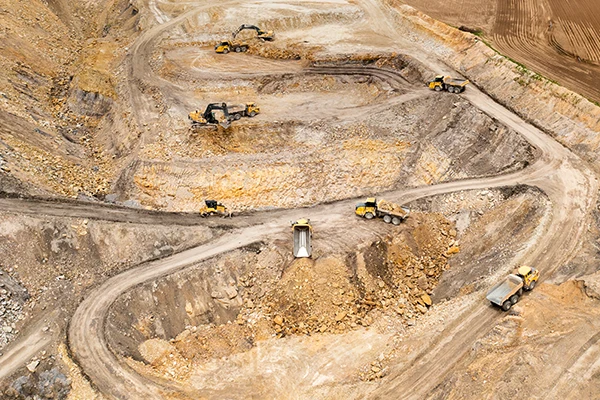Effective asset management goes beyond maximizing productivity and minimizing downtime. It encompasses stringent adherence to regulatory standards to safeguard the environment, ensure worker safety, and maintain operational integrity. In this blog, we will discuss the critical importance of regulatory compliance in mining asset management and explore strategies to ensure adherence to industry regulations.
Regulatory Compliance in Mining:
Mining is among the world’s most dangerous professions, causing approximately 12,000 deaths yearly. While Canada faces mining accidents like the recent tragedy in Sudbury, it maintains relatively low fatality rates. Over three years until 2009, an average of 80 workers annually lost their lives in Canada’s mining, quarrying, and petroleum sectors. Hence, mining operations today are subject to many regulations and standards imposed by government bodies, environmental agencies, and mining associations. These regulations encompass many areas, including environmental protection, health and safety protocols, land reclamation, waste management, and community engagement. Compliance with these regulations is non-negotiable and carries significant legal, financial, and reputational implications for mining companies.
Key Regulatory Challenges in Mining Asset Management:
Mining asset management involves the effective stewardship of a diverse range of assets, including heavy machinery, vehicles, infrastructure, and natural resources. Ensuring regulatory compliance in this complex landscape poses several challenges, including:
Environmental Regulations:
Mining operations must comply with stringent environmental regulations governing air and water quality, waste disposal, habitat preservation, and reclamation efforts. Failure to meet these standards can result in fines, lawsuits, and damage to the company’s reputation.
Health and Safety Standards:
Mining is inherently hazardous, with numerous risks associated with excavation, blasting, transportation, and processing activities. Regulatory bodies mandate strict health and safety protocols to protect workers from accidents, injuries, and occupational illnesses. Compliance with these standards requires robust safety training, hazard identification, emergency preparedness, and personal protective equipment (PPE) protocols.
Mining Permits and Licenses:
Mining companies must obtain various permits, licenses, and approvals from government agencies before commencing operations or undertaking specific activities. These permits often come with conditions related to environmental protection, land use, water rights, and community engagement. Maintaining compliance with permit requirements is essential to avoid regulatory violations and project delays.
Community Relations:
Mining operations often intersect with indigenous lands and local communities, necessitating meaningful engagement, consultation, and consent processes. Regulatory frameworks may require companies to establish community development programs, mitigate social impacts, and address concerns about land rights, cultural heritage, and economic opportunity. Building positive relationships with stakeholders is essential for gaining a social license to operate and mitigating reputational risks.

Strategies for Ensuring Regulatory Compliance:
To navigate the complex regulatory landscape and ensure compliance in mining asset management, companies can implement the following strategies:
Robust Regulatory Monitoring:
Stay abreast of evolving local, national, and international regulatory requirements. Establish a dedicated team or department responsible for monitoring changes in legislation, regulations, permits, and industry standards. Leverage technology and regulatory intelligence platforms to track updates, assess impacts, and implement necessary changes proactively.
Asset Compliance Management Systems:
Implement integrated compliance management systems such as Field Eagle that centralize data, processes, and documentation related to regulatory requirements. Field Eagle’s asset management features facilitate real-time monitoring, reporting, and auditing of compliance activities across the organization. Field Eagle is an asset management tool that is user-friendly, scalable, and customizable to accommodate specific regulatory frameworks and operational contexts.
Learn more: The Benefits Of Cloud-Based Asset Management Solutions For Mining
Proactive Risk Assessment and Mitigation:
Conduct comprehensive risk assessments to identify potential compliance gaps, operational hazards, and regulatory liabilities. Prioritize risks based on their likelihood and potential impact on regulatory compliance, environmental sustainability, and stakeholder relations. Develop proactive risk mitigation strategies, controls, and contingency plans to address identified vulnerabilities and minimize compliance risks.
Stakeholder Engagement and Transparency:
Foster open and transparent communication with regulatory authorities, stakeholders, and affected communities. Engage in meaningful dialogue, consultation, and collaboration to address concerns, share information, and build trust. Demonstrate a commitment to responsible mining practices, ethical conduct, and corporate social responsibility (CSR) initiatives that align with regulatory objectives and societal expectations.
Continuous Improvement and Adaptation:
Embrace a continuous improvement and adaptation culture to respond effectively to changing regulatory landscapes, industry trends, and stakeholder expectations. Invest in ongoing training, education, and capacity-building initiatives to empower employees with the knowledge and skills to uphold regulatory compliance standards. Embrace innovation, technology, and best practices to enhance operational efficiency, environmental performance, and regulatory compliance in mining asset management.
Regulatory Compliance with Field Eagle
In conclusion, ensuring regulatory compliance in mining asset management is paramount for the safety of workers, environmental protection, and operational sustainability. Mining companies face many regulatory challenges spanning ecological protection, health and safety standards, permit requirements, and community relations. To navigate this complex landscape successfully, companies must adopt robust strategies, including proactive regulatory monitoring, and implementing asset compliance management systems like Field Eagle for proactive risk assessment.
To learn more about how Field Eagle can help you ensure regulatory compliance in mining asset management, book a demo today.





